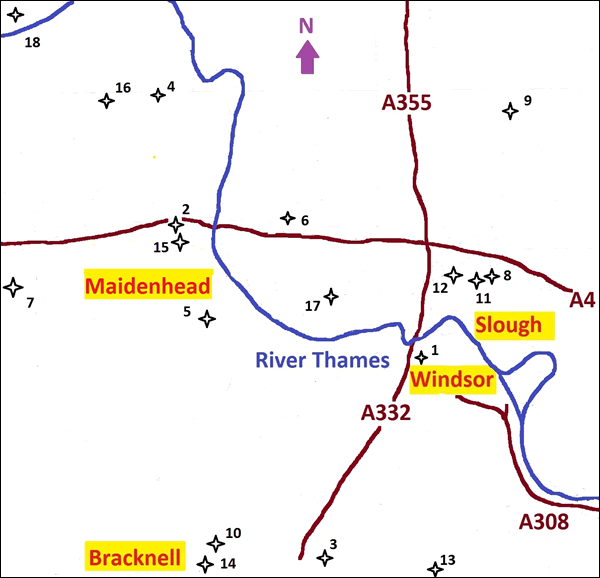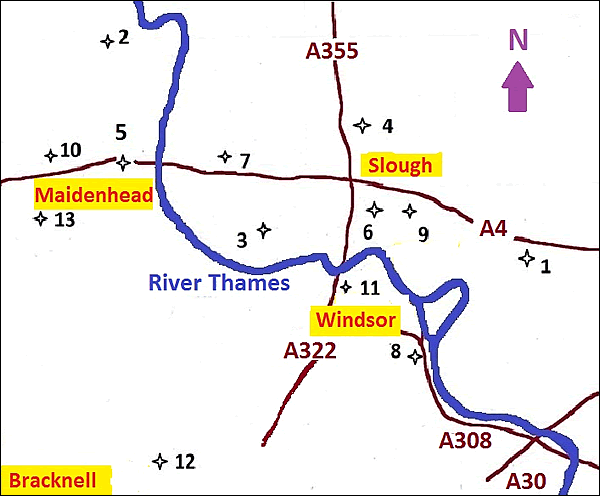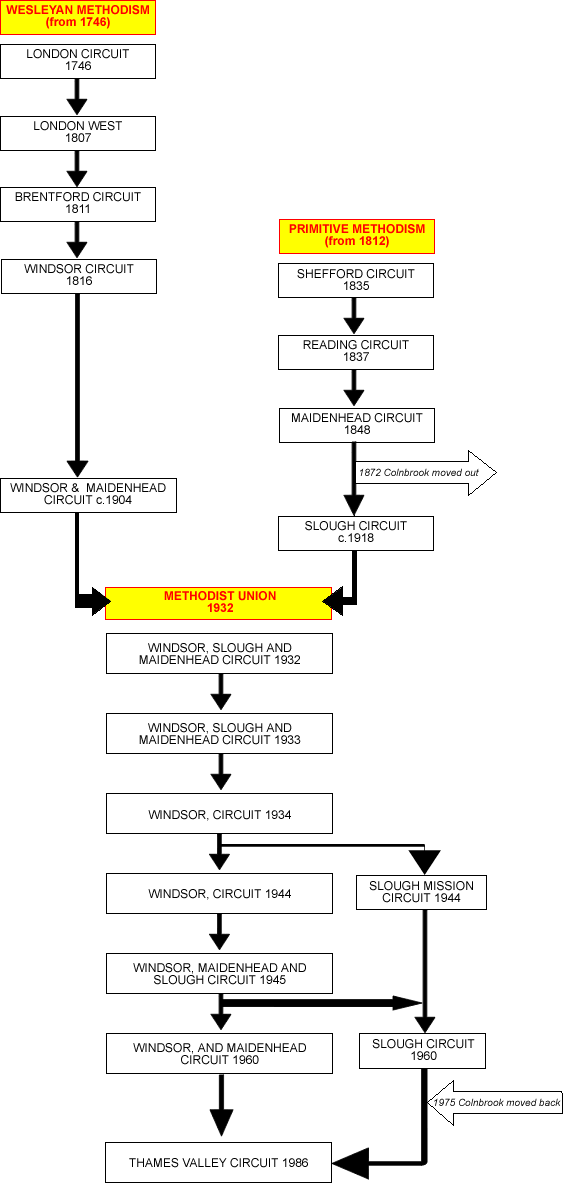The Circuit per se was inaugurated on 1st September 1986, when the Circuits of Windsor & Maidenhead and Slough amalgamated.
However, its origins can be traced back almost to the dawn of Methodism. Both Wesleyan Methodism and Primitive Methodism took hold in this part of the country.
The companion page, A Brief History of Methodism, gives an overview plus an explanation of terms such as Circuit. This page follows up the story for this one special Circuit!
John Wesley first visited Windsor in 1738. The first official list of Circuits, drawn up in 1746, lists six English and one Welsh Circuit. Windsor features in Circuit number 1, the London Circuit, which also covered Surrey, Kent, Essex, Brentford, Egham and Wycombe.1
By 1748, the number of English Circuits had risen to 8. Oxford, Reading, Blewbury and Salisbury had been added to the London Circuit, but Egham no longer appeared.
By 1758, there were 12 English Circuits and the London Circuit had 9 ministers including John Wesley.2
In 1807 the London Circuit was divided into London East and London West.3
In 1811 the Brentford Circuit was created, and our area became part of that Circuit, which stretched from Harrow in the North to Croydon in the South.
The Brentford Circuit was split in 1815 with Windsor becoming a Circuit in its own right with one minister and preaching places in Windsor, Staines, Egham and Chertsey.4 (In 1817 the Brentford Circuit was renamed the Hammersmith Circuit.)5
Slough, a preaching station from the late 1820s, was included in the Wesleyan Circuit Plan in 1844.
John and Jemima Higgs took Methodism from Windsor to Maidenhead, with the first service held there in 1829.6
In 1872 the Windsor Circuit split, with
- Egham, Staines, Chertsey, Chobham and Sand Pitts (Englefield Green) from the Windsor Circuit
- Walton from the Kingston Circuit
forming the new Circuit of Chertsey and Walton-on-Thames. The Churches remaining in the Windsor Circuit7 were:
Windsor
Burnham
Cookham
Holyport
Maidenhead
Slough
Sunninghill
Winkfield
In 1904 the Circuit was renamed Windsor and Maidenhead. The number of Preaching Places had grown, and then consisted of:
Windsor Alma Road
Maidenhead High Street
Cookham
Cookham Rise
Holyport
Lent Rise
Littlewick
Maidenhead Gardener's Cottage
Slough Herschel Street
Stoke Poges
Sunninghill
Winkfield North Street
This Circuit continued until Methodist Union in 1932, by which time Cookham, Gardener's Cottage and Sunninghill had closed.8
Whereas the Wesleyans spread out from London, the Primitives came into our area from the West.
The Primitive Connexion was formed in 1812 with the first Circuit centred at Turnstall in Staffordshire. Missioners were sent around the country, and the second Circuit was formed at Derby in 1816. By 1820 there were 8 Circuits and, by 1833, 101.9
The movement continued to spread East, and the Reading Circuit was formed in March 1837.
This Circuit established a mission in Windsor in 1839. This was renamed the Maidenhead Branch in 1845. It became the Maidenhead Circuit in 1848 with preaching places at10
Maidenhead
Binfield
Bracknell
Cadmore End
Cippenham
Colnbrook
Cookham Dean
Dorney
Drayton
Hatton
Heathrow
Littlewick
Marlow
Staines
Sunninghill
Warfield
Windsor
Winkfield
Some of the preaching places were in cottages, others were open-air sites, and only a few were in Chapels.
In 1872 Colnbrook transferred to the Colnbrook & Uxbridge Circuit, later to the Colnbrook & Chertsey Circuit, and then to the Staines & Feltham Circuit. (See below for 1975 onwards!)
In 1882 the Circuit split into two:11
Cookham Dean
Cox Green
Maidenhead
Marlow
Bracknell
Chalvey
Slough
Winkfield Row
It would seem that neither Circuit prospered. In 1917 the Maidenhead Circuit, with only 150 members across its four Societies and constantly in financial difficulties, petitioned Conference for a Supernumerary or hired Local Preacher instead of a minister. The proposal was rejected, and a Superintendent Minister stationed, but with financial aid towards his moving expenses and stipend. The Windsor Circuit also suffered, and Windsor [Primitive Methodist] Chapel, which had opened around 1853, was forced to close around 1918 due to lack of support. The Circuit was renamed the Slough Circuit.
On 20th September 1932 came the culmination of the great movement for Methodist Union when the Enabling Act was signed in the Royal Albert Hall. Wesleyan, Primitive and United Methodist became legally one Methodist body.
Locally, the two Primitive Methodist Circuits and the one Wesleyan Circuit agreed to form a single Circuit called the Windsor, Slough and Maidenhead Circuit, comprising the Churches
 From:
From:
- Windsor
- Maidenhead High Street
- Cheapside
- Cookham Rise
- Holyport
- Lent Rise
- Littlewick
- Slough, Herschel Street
- Stoke Poges
- Winkfield, North Street
From:
- Slough, William Street
- Slough, Ledgers Road
- Sunningdale
- Winkfield Row
From:
- Maidenhead, Queen Street
- Cookham Dean
- Eton Wick
- Marlow, Chapel Street
Prior to the Union, the two chapels in central Slough, William Street (Primitive) and Herschel Street (Wesleyan) both had rebuilding plans. With union beckoning, they merged resources and, with the aid of a substantial grant from the Joseph Rank Foundation, built Slough Central Hall. This was opened in November 1932 by the Duchess of York, later Queen Elizabeth the Queen Mother — probably the first new Church opened in the newly United Church and one of the last Central Halls.
Hence, within two months of the new Circuit being created, there were already changes! When Slough Central Hall opened in November 1932, both Herschel Street and William Street Churches closed.
In October 1933, the Circuit was renamed the Windsor, Maidenhead and Slough Circuit, and in June 1934, the Windsor Circuit.
In 1942 Slough Central Hall sought to leave the Circuit. After consultation and agreement at Connexional level, the split came into effect in 1944, and when in October 1945, the original Circuit reverted to its previous name, the situation was:
- Slough Mission Circuit, comprising Slough Central Hall
- Windsor, Maidenhead and Slough Circuit:
- the rest listed for September 1932:
- less Marlow, Chapel Street (closed in 1933)
- plus Slough, Hampshire Avenue (opened in September 1936), Maidenhead, Burberry Hall (April 1934), Woodlands Park (September 1934)
North Street Winkfield closed in 1949, and both Littlewick and Stoke Poges closed in 1961.
In November 1953, St Mark's Crescent Church in Maidenhead opened, and Burberry Hall ceased to be used by the Methodists.
In October 1955, the congregations of Maidenhead High Street and Maidenhead Queen Street joined together, with the latter Church closing.
In October 1960, following years of discussion, agreement was reached for all the Churches in Slough to form a Slough Circuit, and this resulted in name changes! The composition of the Circuits was then:
Windsor
Cheapside
Cookham Dean
Cookham Rise
Eton Wick
Holyport
Lent Rise
Maidenhead, High Street
Maidenhead, St Mark's Crescent
Sunningdale
Winkfield Row
Woodlands Park
Slough, Central Hall
Slough, Ledgers Road
Slough, Hampshire Avenue
Britwell (from June 1961)
Bower Way, Cippenham (from November 1952)
Holyport closed in 1961. Bower Way closed in 1965 and the building is now a community centre. The chapels at both Sunningdale and Cheapside closed in July 1969 with the congregations merging with the one at Sunninghill.
In 1966 St Andrew's replaced the Central Hall.
Cookham Dean closed in 1972. Britwell closed in July 1979, and was sold to the Church of God of Prophecy.
In 1975 Colnbrook was transferred to the Slough Circuit from the Staines & Feltham Circuit.
In 1985 discussions started about merging the two Circuits, partly due to a shortage of ministers which meant that both Circuits were vulnerable, partly because in some places the boundaries between the Circuits could no longer be justified logically, but chiefly as it was felt that a merger would enable the Circuits to provide a better and stronger witness in the area. In preference to a variation on the Windsor, Slough and Maidenhead theme, it was agreed that the new Circuit, created on 1st September 1986, should be named the Thames Valley Circuit. It comprised:

- Colnbrook
- Cookham Rise
- Eton Wick
- Hampshire Avenue
- High Street, Maidenhead
- Ledgers Road, Slough
- Lent Rise
- Old Windsor
- St Andrew's, Slough
- St Mark's Crescent, Maidenhead
- Windsor
- Winkfield Row
- Woodlands Park
There have been a few changes since then:
- In July 1987, Poyle URC Church closed, with its members joining with Colnbrook to form the Colnbrook & Poyle United Church.
- In September 1991, Winkfield Row Church transferred to the newly-formed South East Berkshire Circuit along with Bracknell, Crowthorne, Sunninghill, Wokingham and Woosehill.
- Lent Rise Church was renamed Burnham Church.
- Old Windsor Church closed in September 2021.
- Eton Wick Church closed in January 2022.
In summary, the history of the Thames Valley Circuit can be shown thus:

The Current Situation
An illustrated history of each of the Churches in the Circuit is available on this website. Why not find out more?
Methodism in Maidenhead, 1829-1979 by Peter Hardiment, ISBN 0 86023 111 9
The Methodist Church Windsor. The Centenary Story by Jean Kirkwood, 1977
Is it only 25 Years? A History of Methodism in Central Slough by Colin Shepherdson JP, 1991
- Hall's Circuits and Ministers by Rev T Galland Hartley (Methodist Publishing House, 1913) page vi
- Ibid pages vii and v
- Ibid page 306
- The Methodist Church Windsor. The Centenary Story by Jean Kirkwood, 1977, pages 4 - 5
- Hartley op cit page 210
- Expanded in the Church Histories of High Street Maidenhead and St Andrew's Slough.
- Circuit Minute Books and Circuit Plans
- Circuit Plans
- History of the Primitive Methodist Church by Rev H B Kendall, 1919, volume 1 pages 31-40
- Circuit Plans
- Circuit Plans
I wish to express my thanks to the members of each Church who have supplied material and checked these histories, including Peter Hardiment and Hilary Evans for the Cookham Rise and Burham pages.
For the others, I have drawn heavily on previous histories, where they exist, and have also had access to unpublished material by Colin Shepherdson JP.
I am especially indebted to Peter Hardiment and Rev John Newton
My thanks to the staff of the County Records Office (Reading), local History Societies and Museums, for their help.
Ian Haggarty
October 2012